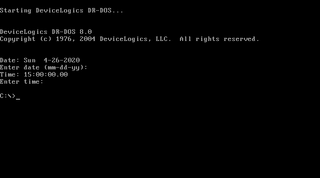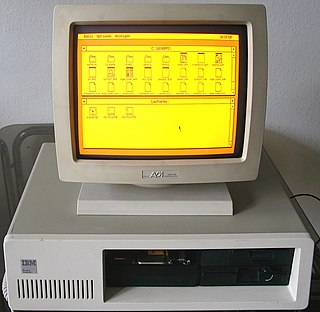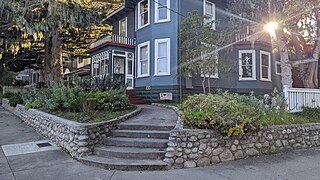
DR-DOS is a disk operating system for IBM PC compatibles. Upon its introduction in 1988, it was the first DOS that attempted to be compatible with IBM PC DOS and MS-DOS.

GEM is a discontinued operating environment released by Digital Research in 1985. GEM is known primarily as the native graphical user interface of the Atari ST series of computers, providing a WIMP desktop. It was also available for IBM PC compatibles and shipped with some models from Amstrad. GEM is used as the core for some commercial MS-DOS programs, the most notable being Ventura Publisher. It was ported to other computers that previously lacked graphical interfaces, but never gained traction. The final retail version of GEM was released in 1988.

Digital Research, Inc. was a privately held American software company created by Gary Kildall to market and develop his CP/M operating system and related 8-bit, 16-bit and 32-bit systems like MP/M, Concurrent DOS, FlexOS, Multiuser DOS, DOS Plus, DR DOS and GEM. It was the first large software company in the microcomputer world. Digital Research was originally based in Pacific Grove, California, later in Monterey, California.
In computing, the working directory of a process is a directory of a hierarchical file system, if any, dynamically associated with the process. It is sometimes called the current working directory (CWD), e.g. the BSD getcwd function, or just current directory. When a process refers to a file using a simple file name or relative path (as opposed to a file designated by a full path from a root directory), the reference is interpreted relative to the working directory of the process. So for example a process with working directory /rabbit-shoes that asks to create the file foo.txt will end up creating the file /rabbit-shoes/foo.txt.

Novell, Inc. was an American software and services company headquartered in Provo, Utah, that existed from 1980 until 2014. Its most significant product was the multi-platform network operating system known as Novell NetWare.

FreeGEM released in 1999 is a windowing system based on Digital Research's GEM which was first released in 1985. GEM stands for "Graphics Environment Manager".

Caldera International, Inc., earlier Caldera Systems, was an American software company that existed from 1998 to 2002 and developed and sold Linux- and Unix-based operating system products.
Star Trek is the code name that was given to a secret prototype project, running a port of Macintosh System 7 and its applications on Intel-compatible x86 personal computers. The project, starting in February 1992, was conceived in collaboration between Apple Computer, who provided the majority of engineers, and Novell, who at the time was one of the leaders of cross-platform file-servers. The plan was that Novell would market the resulting OS as a challenge to Microsoft Windows, but the project was discontinued in 1993 and never released, although components were reused in other projects. The project was named after the Star Trek science fiction franchise with the slogan "To boldly go where no Mac has gone before".

UnixWare is a Unix operating system. It was originally released by Univel, a jointly owned venture of AT&T's Unix System Laboratories (USL) and Novell. It was then taken over by Novell. Via Santa Cruz Operation (SCO), it went on to Caldera Systems, Caldera International, and The SCO Group before it was sold to UnXis. UnixWare is typically deployed as a server rather than a desktop. Binary distributions of UnixWare are available for x86 architecture computers. UnixWare is primarily marketed as a server operating system.

ViewMAX is a CUA-compliant file manager supplied with DR DOS versions 5.0 and 6.0. It is based on a cut-down runtime version of Digital Research's GEM/3 graphical user interface modified to run only a single statically built application, the ViewMAX desktop. Support for some unneeded functions has been removed whilst some new functions were added at the same time. Nevertheless, the systems remained close enough for ViewMAX to recognize GEM desktop accessories automatically and to allow some native GEM applications to be run inside the ViewMAX environment. Many display drivers for GEM 3.xx could be used by ViewMAX as well, enabling ViewMAX to be used with non-standard display adapters and higher resolutions than possible using the default set of ViewMAX drivers. Also, Digital Research's SID86, the symbolic instruction debugger that shipped with DR DOS 3.xx and provided dedicated functions to debug GEM applications, could be used for ViewMAX as well.
Lineo was a thin client and embedded systems company spun out of Caldera Thin Clients by 20 July 1999.

Arachne is an Internet suite containing a graphical web browser, email client, and dialer. Originally, Arachne was developed by Michal Polák under his xChaos label, a name he later changed into Arachne Labs. It was written in C and compiled using Borland C++ 3.1. Arachne has since been released under the GPL as Arachne GPL.
Caldera OpenLinux (COL) is a defunct Linux distribution. Caldera originally introduced it in 1997 based on the German LST Power Linux distribution, and then taken over and further developed by Caldera Systems since 1998. A successor to the Caldera Network Desktop put together by Caldera since 1995, OpenLinux was an early "business-oriented distribution" and foreshadowed the direction of developments that came to most other distributions and the Linux community generally.
Computer hardware or software is said to be bug compatible if it exactly replicates an undesirable feature of a previous version. The phrase is found in the Jargon File.

The AARD code was a segment of code in a beta release of Microsoft Windows 3.1 that would determine whether Windows was running on MS-DOS or PC DOS, rather than a competing workalike such as DR-DOS, and would result in a cryptic error message in the latter case. This XOR-encrypted, self-modifying, and deliberately obfuscated machine code used a variety of undocumented DOS structures and functions to perform its work. The code was present in the installer, in WIN.COM, and in several other executables in the operating system.
Microsoft has been involved in numerous high-profile legal matters that involved litigation over the history of the company, including cases against the United States, the European Union, and competitors.
Fear, uncertainty, and doubt (FUD) is a manipulative propaganda tactic used in sales, marketing, public relations, politics, polling, and cults. FUD is generally a strategy to influence perception by disseminating negative and dubious or false information, and is a manifestation of the appeal to fear.
DOS Protected Mode Services (DPMS) is a set of extended DOS memory management services to allow DPMS-enabled DOS drivers to load and execute in extended memory and protected mode.

DR-WebSpyder is a DOS web browser, mail client and operating system runtime environment that was developed by Caldera UK in 1997. It was based on the DR-DOS operating system and networking components from Novell as well as the Arachne web browser by Michal Polák of xChaos software. The system was designed to run on low-end desktop systems, but being able to boot and execute from disk as well as from ROM or network, it was also tailored for x86-based thin clients and embedded systems with or without disk drives. Using the web browser as its principal user interface, it could be also used for kiosk systems and set-top boxes. It was ported to Linux in 1999 under the name Embrowser and was renamed Embedix Browser in 2000.











